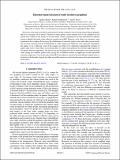Disorder-tuned selection of order in bilayer graphene
Author(s)
Zhang, Junhua; Nandkishore, Rahul Mahajan; Rossi, E.
DownloadPhysRevB.91.205425.pdf (195.1Kb)
PUBLISHER_POLICY
Publisher Policy
Article is made available in accordance with the publisher's policy and may be subject to US copyright law. Please refer to the publisher's site for terms of use.
Terms of use
Metadata
Show full item recordAbstract
The nature of the interaction-driven spontaneously broken-symmetry state in charge-neutral bilayer graphene (BLG) has attracted a lot of interest. Theoretical studies predict various ordered states as the candidates for the ground state of BLG in the absence of external fields. Several experiments have been performed by different groups to identify the nature of the collective ground state in BLG. However, so far, there is no consensus: some experiments show evidence that suggests the establishment of a nematic gapless state, while others present results that are more consistent with the establishment of a fully gapped state. Moreover, even among the experiments that appear to see a bulk gap, some of the samples are found to be conducting (suggesting the existence of gapless edge states), while others are insulating. Here we explore the hypothesis that disorder might explain the discrepancy between experiments. We find that the pair-breaking effect due to nonmagnetic short-range disorder varies among the candidate ground states, giving rise to different amounts of suppression of their mean-field transition temperatures. Our results indicate that BLG can undergo a transition between different ordered states as a function of the disorder strength, providing a possible scenario to resolve the discrepancy between experimental observations.
Date issued
2015-05Department
Massachusetts Institute of Technology. Department of PhysicsJournal
Physical Review B
Publisher
American Physical Society
Citation
Zhang, Junhua, Rahul Nandkishore, and E. Rossi. “Disorder-Tuned Selection of Order in Bilayer Graphene.” Phys. Rev. B 91, no. 20 (May 2015). © 2015 American Physical Society
Version: Final published version
ISSN
1098-0121
1550-235X